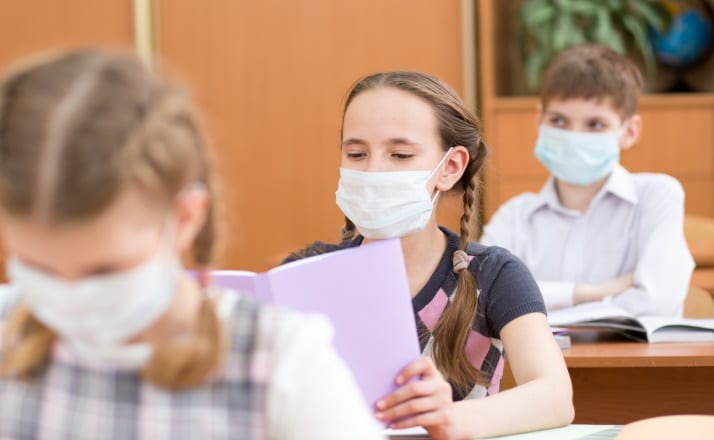The question of whether schools will be opening or not in the fall is one that is weighing heavily on parents all across the country. While the vast majority of us are not looking for a repeat performance of the fresh hell that was distance learning (aka “Spring Semester 2020”), there’s a full gamut of comfort levels in terms of how safe it is for kids to go back to school in the fall.
The CDC released their own suggested “considerations” for school openings back in May that advocated the use of masks, desks spread six feet apart, and no communal cafeteria use.
But parents were stressed by the ideas suggested- little kids wearing masks all day? No normal cafeteria experience? How can a class of 30+ students spread their desks far enough to be considered “socially distanced”??
So the debate rages on: should schools re-open in the fall or not? An influential voice has weighed in on the matter, & says YES.
The American Academy of Pediatrics (AAP) just released an official statement in strong support of opening schools for the coming academic year.

The AAP is extremely influential in encouraging/discouraging various health & safety trends across the nation. In terms of how to deal with the Covid-19’s affect on our educational system, they are calling for as many schools to re-open in the fall as possible, as long as they can do so “safely”.
In their own words, the Academy:
strongly advocates that all policy considerations for the coming school year should start with a goal of having students physically present in school.
They are urging schools not to decide IF they should open, but HOW they should do so.
The AAP examined the dilemma from both a public health perspective (potential virus transmission) and with concern for the implication that the pandemic has had on childrens’ mental health.
In terms of public health, the AAP claims that children are actually less likely to transmit the Covid-19 virus to adults (Were you surprised by that statement? Because I certainly was!).
Educational policy expert Elliot Haspel wrote an editorial advocating for the re-opening of schools that was featured in Early Learning Nation. He points out that:
There are almost no recorded cases of child-to-adult transmission of COVID-19.
And not only that, but even with child-care centers open in certain locations, the rate of positive cases did not skyrocket as one might expect or fear:
France did see 70 cases of COVID-19 among their 1.4 million children who returned to child cares and primary schools. In Texas, there have been cases in 60 of its 11,000 open licensed child cares.
Still, one way of thinking about these numbers is that more than 99 percent of settings have operated with no cases.
Those ratios are pretty darn good.
While the AAP makes the case that opening schools -with their suggested safety measures implemented- is not as great a physical risk as the public might think, they also stress that there’s more at stake if we DON’T re-open schools.
Yes, distance learning filled a gap during an unprecedented public health crisis, but…
Based on recent research conducted about it, it appears that distance learning likely contributed to considerable learning loss as well as social isolation, both which have obviously adverse effects on students.
(And their parents- just saying!!)
The AAP pointed out in their statement that:
Schools are fundamental to child and adolescent development and well-being and provide our children and adolescents with academic instruction, social and emotional skills, safety, reliable nutrition, physical/speech and mental health therapy, and opportunities for physical activity, among other benefits.
Although many of us weary, overwhelmed parents did our best to patch the cracks brewing during our childrens’ spring school semester, there are many other aspects of life at school that simply couldn’t be duplicated during social distancing.
And while we might have managed to muddle our way through fourth-grade math, our kids missed far more than class instruction in the past few months.
They missed socializing, in person, with their peers. They missed the direct interaction with their teachers in a physical classroom. They missed painting in the school art room, running in the school gym.
Special needs students missed out on even more; many of the typical speech/occupational therapy type of services were limited or non-existent simply due to the inability for them to proceed as they normally would.
The AAP warns that the potential mental health effects from NOT re-opening schools in the fall could be worse than the risk of the virus itself.
While distance learning obviously keeps children home with the premise that they are “safe”, the ramifications of increased isolation:
can breed serious social, emotional and health issues: “child and adolescent physical or sexual abuse, substance use, depression, and suicidal ideation.”
Keep in mind that the AAP acknowledges that not all schools might be physically able to adapt for the accommodations that they think are necessary to increase safety, and should gauge that in terms of deciding whether or not to open.
While the AAP is considered the “authority” on all things regarding children and health, this decision is not one that can realistically be looked at as a blanket decision for every family.
The bottom line: As your child’s parent, do your best to stay informed in this ever-shifting news climate. Gauge your own child’s mental health, your own, and consider any medical issues that may put him or her (or your family) at risk in terms of coronavirus transmission.
Then make the decision that you think is best for YOUR FAMILY.











